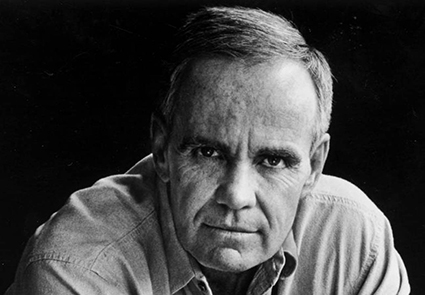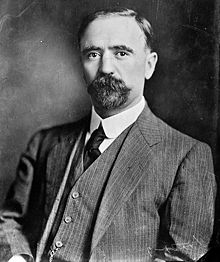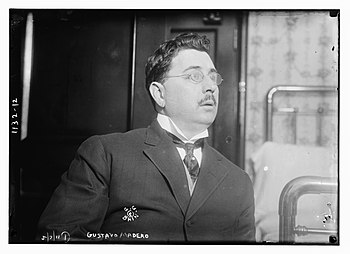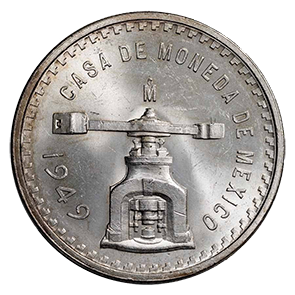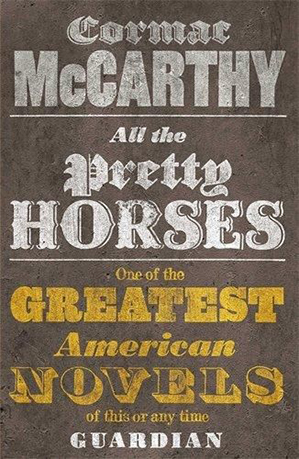
ISBN:9781035003754

The Border Trilogy #1
- Category:Fiction (General), Historical Fiction, Western
- Date Read:17 January 2024
- Year Published:1992
- Pages:310

I’ve been meaning to read All the Pretty Horses for years, ever since a scene from the book was described to a reading group I used to attend, years ago. It’s sat in my imagination for over a decade now. Except, after reading the novel I find the scene doesn’t exist. Maybe it will appear in one of the next two books in The Border Trilogy of which All the Pretty Horses is the first. Maybe the person who described the scene had merely mixed it up. Whatever the case, I found myself thinking a lot about this book as I read it, to the point that I wondered whether I was reading too much into it: whether I was seeing things that weren’t there. The book presents a fairly simple story on the surface. But in the end I decided that if my mind had wandered too far from the source material it was because the novel had inspired those thoughts, anyway. Others can make their own judgment on that.
McCarthy’s novel is primarily about John Grady Cole whose family is at an inflection point in their history. Grady’s maternal grandfather has just died and the ranch that has been in the family for generations is unprofitable and is about to be sold. His mother and father separated after the war. His father is a World War II veteran who has signed away any legal rights he might have had to the ranch when he married. If Grady had any hope of inheriting it, it was through his mother. But his mother has made a new life in San Antonio where she has begun a career on stage. The ranch will be sold no matter what Grady does. The year is 1949.
This is how Cormac McCarthy’s first novel of The Border Trilogy begins: with a sense of loss and of the old ways passing. For Grady the loss of the ranch means more than the loss of economic opportunity. It is a loss of a world that has shaped him and through which he lives. Horses are his passion, and the land upon which they are kept and the power and the “blood and the heat” which runs in them is a visceral reminder of the Indian nations who once owned the land and defended it with their lives and passion. Like the Indian nations before, Grady senses a passing away, a foreshadowing of the changing tide for the white settlers who supplanted them. For Grady, land and horses are part of what defines his identity and the world he has always known. It is a life predicated on the hopes first engendered in the middle decades of the nineteenth century when wagon trains moved westward in search of a new life and opportunity. But as readers, we know Grady lives in a moment when America is changing. The American Dream was originally based on the tenets of its founding documents, of equality and opportunity for all. Arthur Miller’s play, Death of a Salesman, produced the same year that All the Pretty Horses is set, articulates a shift in the American Dream, particularly after World War II, in which the Dream is predicated upon individual success and acquisitive consumerism. Now, just as the country is consolidating its position as a leading nation after World War II and the promise of the American Dream appears ever more obtainable for many Americans, it seems over for Grady.
Grady feels there is little to do except head south into Mexico where he hopes to make a new life. He is accompanied by his friend, Lacey Rawlins, who has previously tried and failed to leave and start anew. For them, the dream they grew up with is lost.
All the Pretty Horses is essentially a Western, with many of the tropes you might expect from the genre. There are vast plains and mountains, river crossings on horses, gunfights, passion, and justice meted out by the barrel of a gun. Describing the book like this makes it sound clichéd and possibly out of step with modern sensibilities. There is a character in Clint Eastward’s 1992 Western, Unforgiven, played by Richard Harris, called English Bob, although Gene Hackman’s character, Bill Daggert, mockingly calls him ‘The Duck of Death’, lampooning Bob’s writing sobriquet, ‘The Duke of Death’. Bob likes to write florid prose detailing his supposed exploits with all the detail and Romantic drama we might expect from the most risible examples of the Western genre. But McCarthy’s prose and his story are not this: it does not rely upon set pieces where dark strangers walk into bars or gunfights happen at noon. Instead, McCarthy captures a feeling, a sensibility, a spirit – none of these words are adequate – of the values of this older world that these young men have inherited. It marks the slow loss of an aspect of the American identity. But is also a paean to an older life that lays outside the tenets of Western culture and the human world.
Essential to this is the word paintings McCarthy forms, at times raising his laconic, precise prose to the heights of poetry, creating a world and universe that reflects the inner landscape of his characters:
He lay on his back in his blankets and looked out where the quartermoon lay cocked over the heel of the mountains. In that false blue dawn the Pleiades seemed to be rising up into the darkness above the world and dragging all the stars away, the great diamond of Orion and Cepella and the signature of Cassiopeia all rising up through the phosphorous dark like a sea-net. He lay a long time listening to the others breathing in their sleep while he contemplated the wildness about him, the wildness within.
When Jimmy Blevins, a young boy of indeterminate age, joins them on the road, it is the natural world that suggests to us the darker impulses in Blevins’ nature. McCarthy uses pathetic fallacy not only to characterise Blevins, but to suggest the cosmic forces McCarthy’s protagonists believe are at play in their lives:
The storm front towered above them and the wind was cool on their sweating faces. They slumped bleary-eyed in their saddles and looked at one another. Shrouded in the black thunderheads the distant lightning glowed mutely like welding seen through foundry smoke. As if repairs were under way at some flawed place in the iron dark of the world.
Blevins’ family has a history of being struck by lightning – Blevins, himself, claims to have already been struck twice – and his fear is the catalyst for the dramatic events of the story.
But associated with this is the question of fate, an issue impossible to avoid for these young men who feel their lives subject to the forces of history. The storm leaves Blevins without his clothes or horse. The storm is an ominous harbinger suggested by the image of birds that have also suffered its fury:
. . . they passed a stand of roadside cholla against which small birds had been driven by the storm and there impaled. Grey nameless birds espaliered in attitudes of stillborn flight or hanging loosely in their feathers.
Rawlins believes in fate: “I wouldn’t be here if I wasn’t supposed to be here” he tells Grady. Whether we are agents in our own lives or puppets of fate is a central concern of the book. A man can neither deny his birth nor the country he was born in. Rawlins believes in an essential self: “My daddy run off from home when he was fifteen. Otherwise I’d of been born in Alabama” he tells Grady, initially missing the point which Grady articulates for him, that a different mother would also result in him being other than he is: “If your mama had a baby with her other husband and your daddy had one with his other wife which one would you be?” The logic of the argument suggests there is no destiny in existence, but neither can we escape our genetic inheritance. The fallacy and logic of Rawlins’ statement is repeated by Grady’s fellow Mexican workers when they speak of country:
. . . a man leaves much when he leaves his own country. They said that it was accident of circumstance that a man be born in a certain country and not in some other and they said that the weathers and seasons that form a land form also the inner fortunes of men in their generations and are passed on to their children and are not so easily come by otherwise.
Country, itself, is like genetic inheritance, forming and shaping identity. But it does not ordain the course of our lives. Rawlins’ own father has changed destiny, already, if destiny exists, when he ran from home. Grady’s mother may be changing destiny once again, since Grady has seen her on the arm of another man in San Antonio. And as Grady falls in love and seeks a life with Alejandra in Mexico, his actions also have the potential to shape the future. It is an insight that lifts McCarthy’s narrative above maudlin nostalgia for what is lost. That while the vast forces of history seem to shape lives like the weather shapes the landscape, there is agency in human existence.
It is an idea that is magnificently realised in the image of the coin presser, explained to Grady by Dueña Alfonsa. Alfonsa is the aunt of Alejandra with whom Grady begins a relationship. Grady and Rawlins have turned up at La Purísima, a large ranch or hacienda in the state of Coahuila, where they are taken in and given positions of trust. Grady’s horse breaking skills bring him to the attention of Don Hector, who wishes him to trap wild horses and break them, as well as help him breed quarterhorses for the purposes of racing. When Grady’s secret relationship with Alejandra becomes apparent to Alfonsa, she invites Grady to a chess game, another metaphor: he wins the first two games; she wins the last. Alfonsa warns Grady away from Alejandra. Later in the novel, when Grady’s fortunes have turned, she speaks to him again. Alfonsa tells him, “I can scarcely count on my two hands the number of women in this family who have suffered disastrous love affairs with men of disreputable character.” Unexpectedly, Alfonsa is speaking of herself. Alfonsa’s lover was Gustavo Madero, brother to the famous Francisco Madero who became the Mexican president following an election after Francisco led a rebellion that saw the former long-term president, Diaz, deposed. Madero’s grandfather, Don Evaristo, was Don Hector’s godfather. Don Hector’s family is intimately connected with the forces of revolution that transformed Mexico in 1911. Now, Mexico is a stable country aligned with America, even though America helped the rebels depose Diaz. But Alfonsa, personally, has been left somewhat embittered by the violent events that ended with the assassination of Francisco and the violent death of Gustavo in 1913. The image she uses to explain her understanding of fate – the coin presser – once again delineates between conception (literally the forces that shape a coin) and its subsequent history, as explained to her by her father:
The example he gave was of a tossed coin that was at one time a slug in a mint and of the coiner who took that slug from the tray and placed it in the die in one of two ways and from whose act all else followed, cara y cruz. No matter through whatever turnings nor how many of them. Till our turn comes at last and our turn passes.
Alfonsa’s metaphor works at the level of our personal lives but also on a cosmic scale. ‘Cara y cruz’ – heads or tails – suggests chance , but can also suggest fate or destiny. At the beginning of Tom Stoppard’s Rosencrantz and Guildenstern are Dead a coin lands heads ninety-two times in a row; an ominous sign that the two men cannot escape fate. But in Alfonsa’s story the coiner peers “with his poor eyes through dingy glasses at the blind tablets of metal before him.” Meaning and purpose is not imbued in our creation but in what happens subsequently. If God is the coiner pressing coins, their subsequent existence is independent from the moment of their pressing. Alfonsa extends this argument by mixing her metaphors:
For me the world has always been more of a puppet show. But when one looks behind the curtain and traces the strings upward he finds they terminate in the hands of yet other puppets, themselves with their own strings which trace upward in turn, and so on.
Alfonsa’s conception of fate is distinctly secular.
If fate resides within the will of humanity, so too must its soul and its redemption. When Grady’s horse is claimed by other men it is impounded and he must go to court to reclaim it. Grady regains his horse because the judge who hears his case hears the truth of his story. Even so, Grady appears at the judge’s house that night, seeking a confessor. It is through the law, not religion, by which Grady seeks redemption, telling the judge that he cannot accept being mistaken for a good man or in the right of everything. In confessing, Grady finds a common humanity with the judge who has been forced, as Grady has been forced, to make hard decisions against his will. In contrast, the Reverend Jimmy Blevins whom Grady seeks out, believing he may be a relative of the young Jimmy Blevins, proves to be a religious charlatan offering sham healing sessions over the radio waves.
Spirituality in All the Pretty Horses is expressed through common Christian paradigms by its protagonists, but the understanding of a spiritual self and purpose is understood in the world of nature and the souls of horses. Luis, a Mexican worker that Grady works with, tells him that horses share a common soul, and if one could understand the soul of one horse, they all would be understood, while humans share no common soul and cannot be understood. Luis assures Grady that God would not permit horses to vanish from the earth, and since horses share a common soul, there is no need for a heaven for horses. In essence, the soul of the horse is connected to nature while those of men is not. Grady often dreams of horses, and it is in a dream that Grady recalls the insight Luis has provided. He dreams of horses moving about a graveyard with its tilted stones and their writing faded by time. The horses are aware that they are “carrying in their blood as they did the recollection of this and other places where horses once had been and would be again.” Grady understands that horses, and by extension the natural world upon which humans write their narrative in deeds and blood, “was more durable for it was written in a place where no rain could erase it.”
This, it seems, is the fate of humanity. For humanity often exists by exploiting nature, like the horses Grady and Rawlins capture for Don Hector. And here we have a metaphor for humanity’s hubris. The idea that nature can be controlled, so that the world and systems upon which its human occupation is predicated, is revealed as absurd. History turns, fortunes change, and societies evolve. Yet Nature exists, thunderstorms roll across the landscape, horses stampede across the plains, but not in deference or reference to the human world. Instead, it is the human world that is conditional and temporary, and it is this fact that is understood through the meta-narratives of fate and religion.
From this we may infer a grand narrative in All the Pretty Horses about America and how it has shaped itself. America’s revolution and founding documents are central not only to America’s identity, but also its sense of purpose and place in the world after the Second World War. They are, so to speak, the coiner’s stamp. But America’s twentieth century ascendancy does not guarantee its permanence, and nor can it remain static. America is as much subject the whims of history as Mexico, at least starting from its own revolution in 1911 as recounted by Alfonsa. By 1992 when McCarthy published this book, the Soviet Union had failed and America had demonstrated its military and technological dominance in the First Gulf War. The idea of the End of History and America as the only superpower in the world gave rise to the talk of a second American century. But McCarthy’s book belies that success. There is no fate or destiny only what we choose to do: “. . . our turn comes at last and our turn passes.”
McCarthy’s novel is no mere Western, although the preview of Billy Bob Thornton’s film adaptation hints at the degree to which the story does follow the conventional tropes of the Western genre and even a love story. Yet there is a profundity to the writing that is never forced or may not even be apparent as you read. Grady and Rawlins cross the Rio Grande riding their horses and then team up with Jimmy Blevins who, by the turn of his own impulsive character, becomes an outlaw. There is love, as we might expect, prison, deadly struggles and a landscape that dwarfs its human drama. If you read this novel, you’re reading it for a great story – even a familiar story – along with the adventure and all that that kind of story promises. But there are other aspects that are worth thinking about before you close the cover on the last page. It’s a book worth thinking about, too.
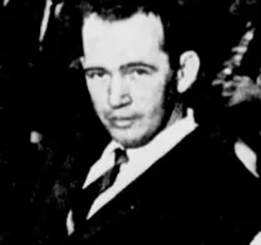
James Blevins is the likely inspiration for McCarthy’s protagonist in Child of God. Blevins was arrested and convicted of the murders of two lovers at Lula Lake, Georgia, committed in 1963, but his conviction was later overturned on a technicality. McCarthy’s character Jimmy Blevins in All the Pretty Horses is possibly as young as thirteen years old. He has an impulsive nature, takes offence easily and has an obdurate will. Their chance meeting with Blevins on their way south through Mexico will change the lives of Rawlins and Grady forever. McCarthy’s use of the name in this novel is interesting, since he never absolutely confirmed that Blevins was his model for Lester Ballard in Child of God.
